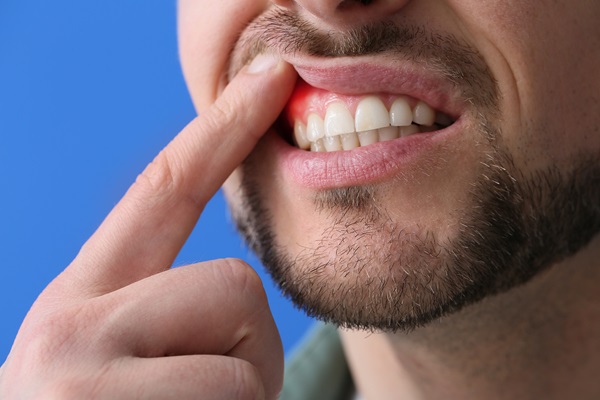The Stages of Gum Disease and When To Seek Treatment

Gum disease is a common yet serious condition that negatively impacts oral health if left untreated. The condition can result from plaque and bacteria buildup, starting with mild symptoms and leading to tooth loss. Knowing the stages of gum disease and when to seek treatment can help protect your gums and teeth.
What is Gum Disease?
Gum disease, or periodontal disease, is an infection of the gums and surrounding tissues that support teeth. It develops in stages, starting with mild symptoms and becoming more severe. It typically starts with plaque, a sticky film of bacteria that forms on the teeth. If this plaque stays on the teeth, it hardens into tartar, which can irritate the gums and cause infection. The earlier gum disease treatment begins, the better the chances of preventing permanent damage to the gums and teeth.
The Stages of Gum Disease
Stage 1: Gingivitis
Gingivitis results from plaque buildup along the gum line, irritating and inflaming the gums. Mild symptoms often mark this initial stage of gum disease, such as redness, swelling, tenderness, and bleeding during brushing or flossing. Luckily, proper oral hygiene and professional dental cleanings can reverse gingivitis. Regular brushing, flossing, and routine visits to the dentist can help eliminate plaque and restore gum health. If left untreated, however, gingivitis can progress to more serious stages of gum disease.
Stage 2: Early Periodontitis
Untreated gingivitis progresses to early periodontitis, which spreads below the gumline. At this stage, the gums may pull away from the teeth, forming pockets where bacteria and plaque collect. These pockets make it harder to clean the teeth properly, worsening the infection.
Early periodontitis symptoms may include persistent bad breath, increased gum sensitivity, and noticeable gum recession. Treatment at this stage is essential to prevent further damage. A dentist may recommend scaling and root planing, a deep cleaning procedure that removes plaque and tartar below the gumline and smooths the tooth roots to encourage healing.
Stage 3: Moderate Periodontitis
Moderate periodontitis is a more advanced stage of gum disease that causes significant damage to the gums and bone supporting the teeth. At this stage, the pockets around the teeth deepen, and more bacteria accumulate, leading to further gum recession and bone loss.
Loose teeth, noticeable gaps between teeth, and increased pain and sensitivity are symptoms of this disease. Without treatment, moderate periodontitis can lead to permanent damage, including tooth loss. The dentist may recommend more intensive treatments, such as surgical procedures to clean infected areas or regenerate bone and tissue.
Stage 4: Advanced Periodontitis
This condition is the most severe stage of gum disease, often resulting in tooth loss and widespread damage to the gums and jawbone. With advanced periodontitis, the infection has destroyed much of the bone and connective tissue that hold the teeth in place.
Symptoms of advanced periodontitis include severe pain, difficulty chewing, and significant tooth mobility. The gums may appear shrunken or receded, and teeth may fall out or need extraction. Treatment for advanced periodontitis may involve surgical interventions, such as bone grafts, tissue regeneration, or tooth replacement options like dental implants.
When to Seek Treatment
It is key to seek treatment for gum disease as soon as the patient notices symptoms. Additionally, regular dental checkups can help catch gum disease in its early stages, even if the patient does not have noticeable symptoms. Those experiencing advanced symptoms, such as gum recession, loose teeth, or severe pain, should consult their dentist immediately, as prompt treatment can prevent further damage and help restore your oral health.
How to Prevent Gum Disease
Preventing gum disease starts with maintaining good oral hygiene habits. Brushing twice daily, flossing at least once daily, and using an antimicrobial mouthwash can help reduce plaque buildup and keep gums healthy. These habits should be coupled with regular dental cleanings and checkups so a dentist can remove plaque and tartar missed by brushing and flossing.
Healthy lifestyle choices like eating a balanced diet and avoiding tobacco products can also support gum health. Taking proactive steps can lower the risk of developing gum disease and protect the smile.
Protect your gums and teeth
Gum disease is a serious but preventable condition when caught early. Understanding its stages and seeking timely treatment can protect your gums and teeth from long-term damage. Schedule an appointment with your dentist today to avoid gum disease and maintain a healthy smile. If it has been a while since you have seen a dentist, call to make an appointment today.
Request an appointment here: https://drcalldental.com or call Dr. Call Dental Center at (706) 425-6240 for an appointment in our Dalton office.
Check out what others are saying about our dental services on Yelp: Gum Disease in Dalton, GA.
Related Posts
Many people think it is a normal part of an oral care routine, but dentists warn that bleeding gums are a sign something is wrong. When you brush and floss your teeth, sometimes you may see a little blood coming from your gums. In most cases, bleeding gums are a sign that you may have…
There are many reasons why bleeding gums may occur. If it only happens once in a while, it is typically not cause for concern. Gums can bleed because of brushing or flossing that is overly vigorous. If bleeding is an ongoing occurrence, however, there may be an underlying medical or dental condition causing it. The…
Patients do not have to accept bleeding gums as part of routine oral health maintenance as this condition can lead to more advanced forms of gum disease. It can easily be treated with specialized products in the early stages. These patients should visit a dentist as soon as possible after noticing gum inflammation or bleeding…
Food and drink have a lot to do with oral health, but certain medications can also have an impact. While bleeding gums are often associated with signs of plaque buildup along the gum line, it is possible for those who take blood thinners to be more susceptible to this condition as well.Blood thinners are used…


